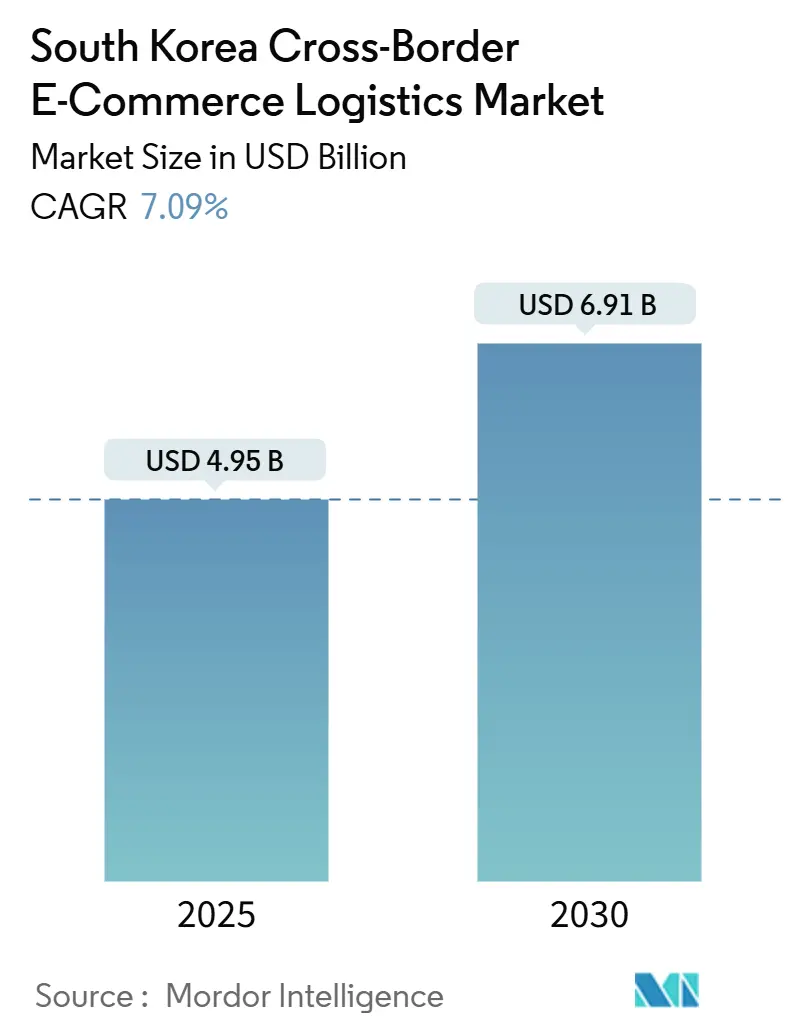
| Study Period | 2019 - 2030 |
| Base Year For Estimation | 2024 |
| Forecast Data Period | 2025 - 2030 |
| Market Size (2025) | USD 4.95 Billion |
| Market Size (2030) | USD 6.91 Billion |
| CAGR (2025 - 2030) | 7.09 % |
| Market Concentration | Medium |
Major Players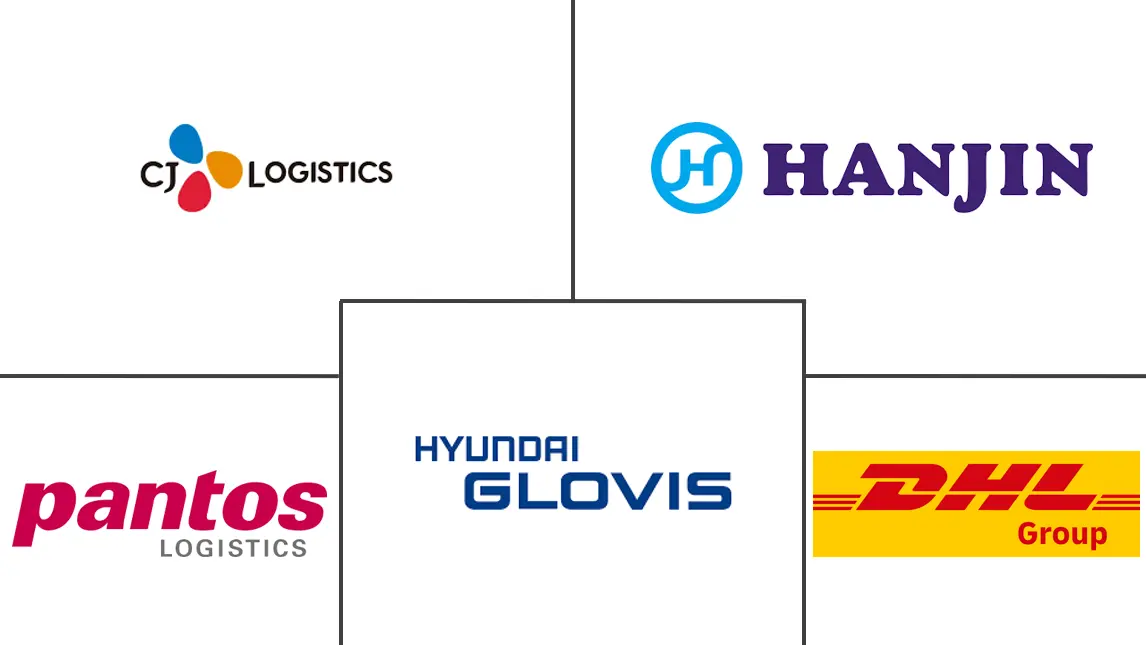
*Disclaimer: Major Players sorted in no particular order |
South Korea Cross-Border E-Commerce Logistics Market Analysis
The South Korea Cross-Border E-Commerce Logistics Market size is estimated at USD 4.95 billion in 2025, and is expected to reach USD 6.91 billion by 2030, at a CAGR of 7.09% during the forecast period (2025-2030).
The South Korean cross-border e-commerce logistics market is experiencing significant transformation, driven by the rapid growth of cross-border e-commerce. As international shopping platforms gain prominence, leading logistics companies such as CJ Logistics and Hanjin are scaling up their Global Distribution Centers (GDC) in Incheon to meet the rising demand for cross-border services. These expansions aim to enhance the processing capacity of self-clearance facilities, ensuring seamless and efficient delivery solutions. Intensifying competition among logistics providers is further propelled by Chinese e-commerce firms adopting a “Koreanization strategy,” which involves establishing logistics centers in South Korea to streamline shipping and returns processes. This strategy has significantly boosted cross-border transactions, with Korean consumers completing over 67 million cross-border purchases of Chinese goods in 2023, underscoring the critical need for robust logistics systems to support the expanding e-commerce market.
Government initiatives have been pivotal in strengthening logistics infrastructure to accommodate this rapid growth. As of early 2024, the South Korean government has implemented policies to improve cross-border logistics efficiency, including the introduction of e-commerce-friendly regulations and tax incentives for logistics companies. Additionally, substantial investments have been made to upgrade logistics hubs and infrastructure, focusing on smart logistics solutions that integrate technologies such as real-time tracking and automation to reduce operational costs and enhance delivery speeds. These measures align with South Korea’s strategic push for digital transformation in logistics, positioning the country as a leader in the regional cross-border logistics market.
Technological advancements are reshaping the cross-border logistics sector. South Korean companies are adopting advanced technologies such as blockchain to enhance transparency and security, and artificial intelligence (AI) to optimize routes and forecast demand. The rise of “smart” logistics centers, equipped with automated sorting systems and AI-driven inventory management, is enabling faster and more cost-effective cross-border operations. For example, in February 2024, South Korea’s transport ministry will launch a demonstration of urban smart parcel delivery services using a micro fulfillment center in southern Seoul. This automated logistics hub will serve as the base for quick-delivery services, utilizing six robots to sort and transport parcels within the facility. These technological advancements are not only driving efficiency for local logistics firms but also creating opportunities for international players to enter the South Korean market.
In conclusion, the South Korean cross-border e-commerce logistics market is poised for sustained growth in 2024 and 2025, fueled by the expansion of e-commerce and strategic initiatives by both the government and private logistics firms. The development of logistics infrastructure, coupled with technological advancements, is facilitating faster, more secure, and efficient cross-border trade. With strong government support and increasing demand for cross-border e-commerce services, South Korea’s cross-border e-commerce logistics market is well-positioned for continued expansion, benefiting both domestic and international stakeholders.
South Korea Cross-Border E-Commerce Logistics Market Trends
The Surge of Chinese E-Commerce Platforms in South Korea
The South Korean cross-border e-commerce logistics market in 2024 is witnessing a growing dominance of Chinese e-commerce platforms, particularly in the fashion sector. In December 2024, Alibaba Group invested KRW 100 billion (USD 71.4 million) in Ably Corp., a leading women's clothing app operator in South Korea. This secured a 5% stake in Ably, now valued at over USD 1 billion. Ably's user base and transaction volume have reached 2 trillion won, reflecting the rapid growth of South Korea's online fashion market. Alibaba also announced plans for a 180,000-square-meter logistics center in South Korea to support the expanding e-commerce network.
Other Chinese e-commerce giants, including Shein, AliExpress, and Temu, are also expanding their presence in South Korea. In May 2024, the South Korean government signed a product safety agreement with these platforms to address rising concerns over product quality and safety. This agreement coincided with a significant increase in South Korean consumers engaging with these platforms, as AliExpress and Temu rapidly grew their user bases. The regulatory agreement reflects South Korea's efforts to protect consumers while supporting the growth of foreign platforms in its market.
Shein, a major player in fast fashion, strengthened its position in South Korea by opening its first offline pop-up store in Seoul's trendy Seongsu-dong district in July 2024. This move aligns with Shein's strategy to integrate online and offline retail, targeting South Korea's fashion-conscious consumers. At the same time, South Korean e-commerce companies are expanding their cross-border operations to remain competitive. As part of its strategy, Alibaba extended the global free shipping zone of platforms like Taobao to include South Korea, making shopping on Chinese platforms more cost-effective for local consumers.
Chinese e-commerce leaders Alibaba, Shein, and AliExpress are disrupting South Korea's fashion segment in the cross-border e-commerce logistics market. Backed by investments, regulatory support, and online-offline integration, they are strengthening their market position. As South Korean firms counter this growth, cross-border logistics remains critical in the evolving competitive landscape.
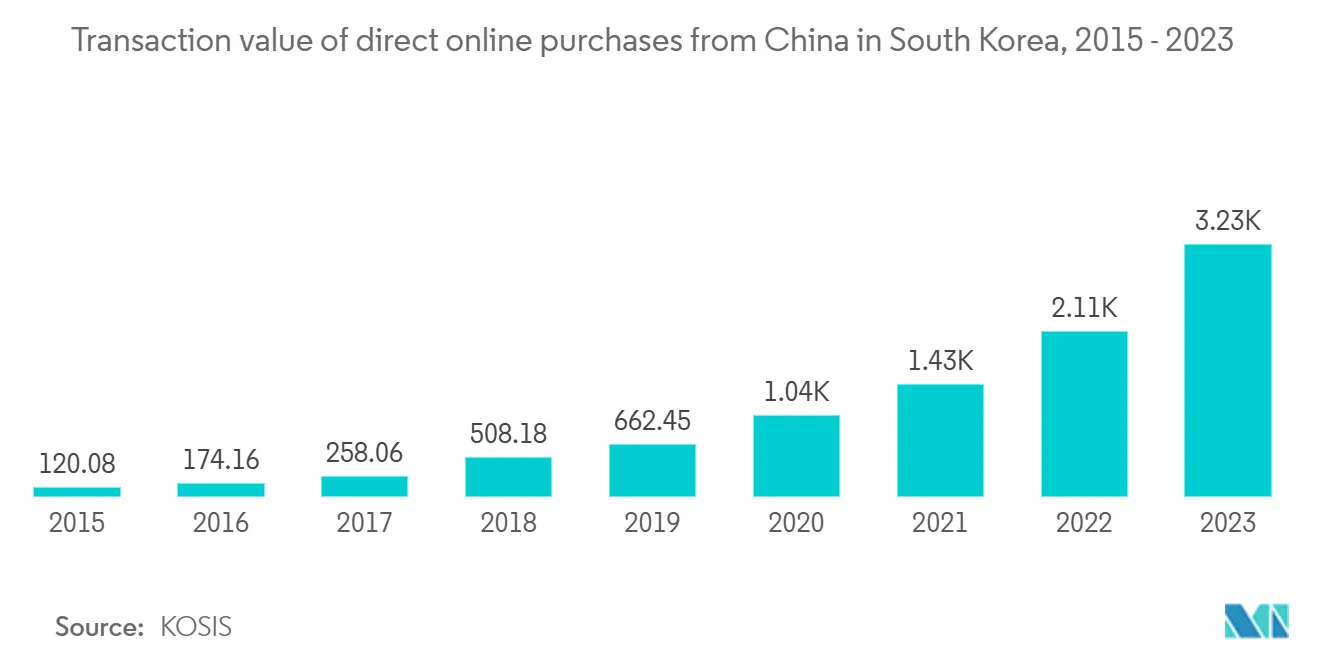
Growth in K-Beauty Exports Driving Cross-Border E-Commerce Logistics in South Korea
The South Korean government’s strategic initiatives have been instrumental in driving the robust growth of K-beauty exports. In Q1 2024, cosmetic exports rose 22% year-on-year, reaching a record high. To capitalize on this growth, the government partnered with industry leaders to support SMEs. Programs like the K-beauty Creator Challenge collaborate with Amazon and manufacturers such as CJ Olive Young, Cosmax, and Kolmar to promote export-ready firms. Exports to Mexico, a key market with strong cosmetics demand, increased 51% year-on-year, highlighting opportunities in global logistics expansion.
Leading K-beauty brands have leveraged global demand to achieve significant market penetration. Indie brands like Beauty of Joseon, d’Alba, and LAKA have secured competitive positions internationally. Beauty of Joseon’s “Relief Sun: Rice + Probiotics” became a top-selling sunscreen on Amazon and Olive Young. d’Alba’s “Waterfull Tone-up Sunscreen” gained traction in Japan, ranking high on Qoo10 Japan and Rakuten. LAKA’s “Fruity Glam Tint” led the Japanese lip tint category on the Lips app. These successes drove strong financial results, with Beauty of Joseon reporting a 250% sales increase (90% from international markets) and d’Alba achieving a 135% rise in global sales.
Kolmar Korea, a leader in cosmetics manufacturing, is enhancing South Korea's cross-border e-commerce logistics through technological innovation and global expansion. Allocating 7% of annual sales to R&D, the company holds over 561 patents, including advancements in vitamin C formulations. In 2024, Kolmar launched the NJ Innovation Center in New Jersey, leveraging big data for R&D, and announced plans for a second U.S. manufacturing facility in Pennsylvania. With record sales of KRW 2.1 trillion in 2023, Kolmar's ODM focus drives its growth, alongside expansion plans in Europe and the Middle East.
South Korea's rapid K-beauty export growth reinforces its position as a global leader in cosmetics innovation and manufacturing. With brands achieving international success and companies like Kolmar driving advancements, demand for efficient logistics solutions is rising. The synergy of product innovation, government support, and growing global demand strengthens South Korea’s leadership in cosmetics e-commerce logistics.
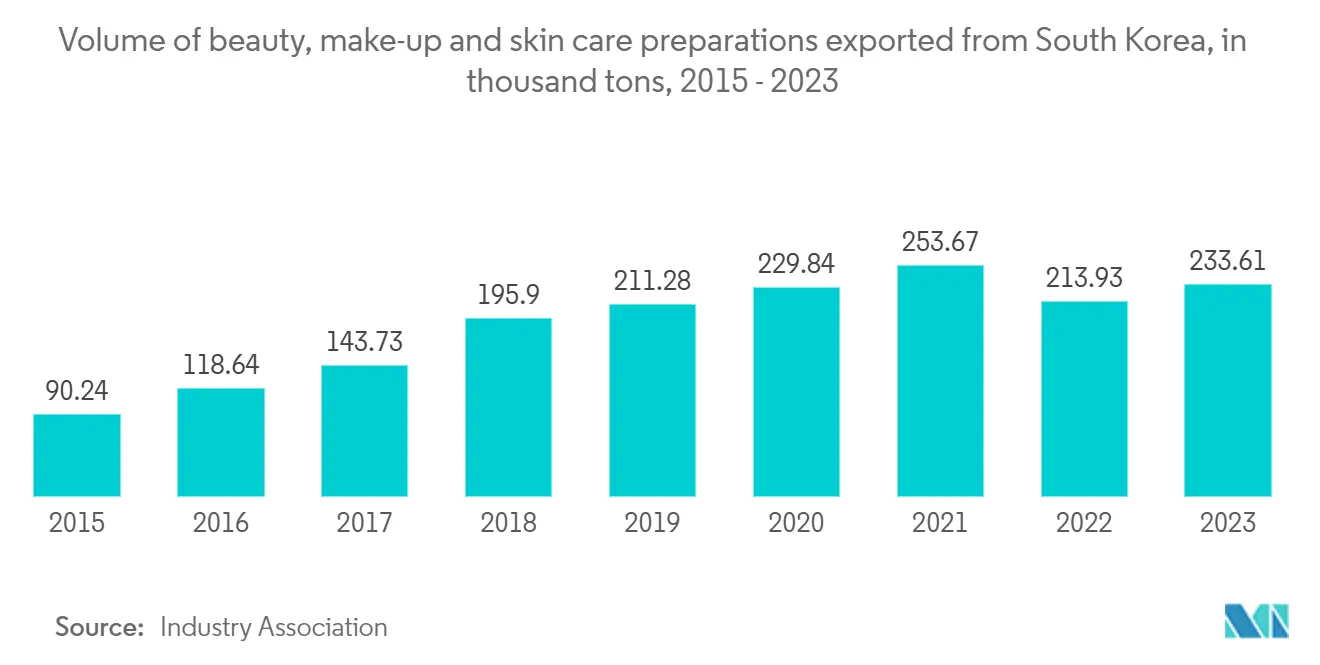
South Korea Cross-Border E-Commerce Logistics Industry Overview
The South Korean cross-border e-commerce logistics market is witnessing robust growth, driven by the increasing demand for international products and the expansion of global e-commerce platforms. Logistics companies are focusing on enhancing infrastructure, streamlining operations, and adopting advanced technologies to ensure efficient and seamless delivery services. These efforts are positioning South Korea as a key hub for cross-border logistics in the region.
The market is also benefiting from innovative strategies, such as the implementation of automation and digital tools, which are improving supply chain efficiency. Government support for digital transformation and logistics modernization further strengthens the market’s potential. As companies continue to innovate and invest, the South Korean cross-border logistics sector is well-equipped to meet growing consumer expectations and sustain its positive trajectory.
South Korea Cross-Border E-Commerce Logistics Market Leaders
-
CJ Logistics
-
Hanjin
-
Hyundai Glovis
-
Pantos Logistics
-
DHL Group Logistics
- *Disclaimer: Major Players sorted in no particular order
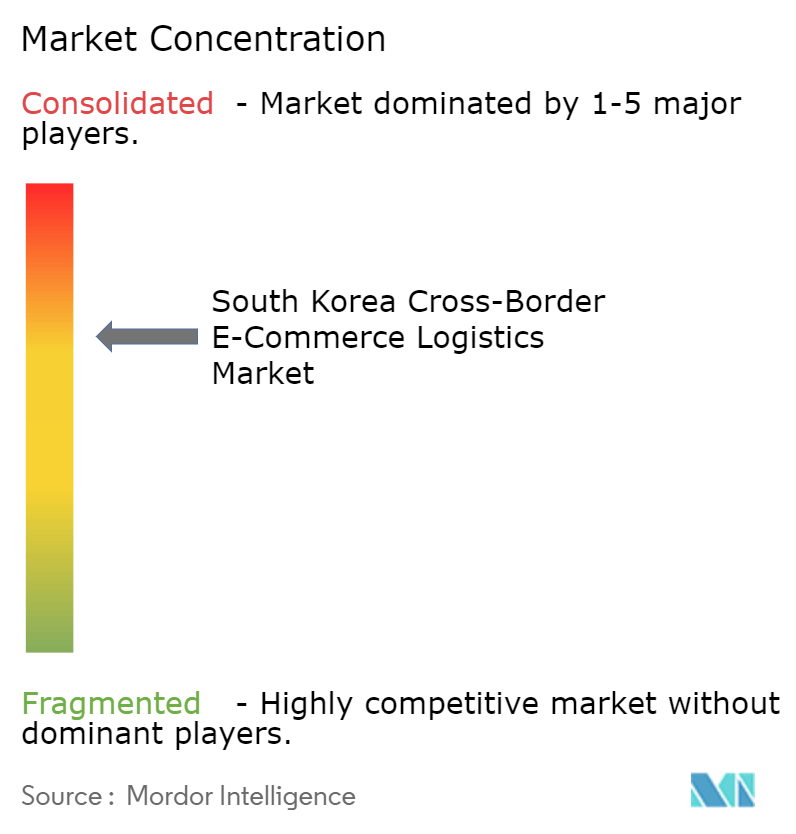
South Korea Cross-Border E-Commerce Logistics Market News
- April 2024: Hanjin is enhancing its air express delivery operations by investing in the customs clearance center at Incheon International Airport's International Logistics Center (GDC). This strategic investment will enable Hanjin to double its customs clearance capacity, increasing from 1.1 million boxes per month to 2.2 million boxes. The facility upgrade involves an investment of approximately KRW 10 billion (USD 7.41 million).
- April 2024: KKR has completed the sale of the Incheon Seoknam Coupang Logistics Center, a 299,244 square meter (3.2 million square foot) state-of-the-art facility located in Incheon, to Korea's IGIS Asset Management for a transaction value exceeding USD 366 million. This strategic divestment reflects the increasing demand for advanced logistics infrastructure, driven by the rapid growth of the online shopping market in northern Asia.
South Korea Cross-Border E-Commerce Logistics Industry Segmentation
The South Korea cross-border e-commerce logistics market involves the transportation, warehousing, and delivery services necessary to enable the movement of goods purchased online across international borders. This market is integral to connecting global e-commerce platforms with South Korean consumers, ensuring streamlined and efficient order fulfillment processes.
The report provides a comprehensive background analysis of the South Korea cross-border e-commerce logistics market, covering the current market trends, restraints, technological updates, and detailed information on various segments and the industry's competitive landscape. Additionally, the impact of geopolitics and the pandemic has been incorporated and considered during the study. The South Korea cross-border e-commerce logistics market is segmented By Service (Transportation, Warehousing and Inventory Management and Value-added Services (Labeling, Packaging)), By Business (B2B (Business-to-Business) and B2C (Business-to-Consumer)) and By Product (Fashion and Apparel, Consumer Electronics, Home Appliances, Furniture, Beauty and Personal Care Products and Other Products (Toys, Food Products, Etc.). The report offers the South Korea cross-border e-commerce logistics market size and forecasts in values (USD) for all the above segments.
| By Service | Transportation |
| Warehousing and Inventory Management | |
| Value-added Services (Labeling, Packaging ) | |
| By Business | B2B (Business-to-Business) |
| B2C (Business-to-Consumer) | |
| By Product | Fashion and Appareal |
| Consumer Electronics | |
| Home Appliances | |
| Furniture | |
| Beauty and Personal Care Products | |
| Other Products (Toys, Food Products, Etc.) |
South Korea Cross-Border E-Commerce Logistics Market Research FAQs
How big is the South Korea Cross-Border E-Commerce Logistics Market?
The South Korea Cross-Border E-Commerce Logistics Market size is expected to reach USD 4.95 billion in 2025 and grow at a CAGR of 7.09% to reach USD 6.91 billion by 2030.
What is the current South Korea Cross-Border E-Commerce Logistics Market size?
In 2025, the South Korea Cross-Border E-Commerce Logistics Market size is expected to reach USD 4.95 billion.
Who are the key players in South Korea Cross-Border E-Commerce Logistics Market?
CJ Logistics, Hanjin, Hyundai Glovis, Pantos Logistics and DHL Group Logistics are the major companies operating in the South Korea Cross-Border E-Commerce Logistics Market.
What years does this South Korea Cross-Border E-Commerce Logistics Market cover, and what was the market size in 2024?
In 2024, the South Korea Cross-Border E-Commerce Logistics Market size was estimated at USD 4.60 billion. The report covers the South Korea Cross-Border E-Commerce Logistics Market historical market size for years: 2019, 2020, 2021, 2022, 2023 and 2024. The report also forecasts the South Korea Cross-Border E-Commerce Logistics Market size for years: 2025, 2026, 2027, 2028, 2029 and 2030.
South Korea Cross-Border E-Commerce Logistics Industry Report
Statistics for the 2025 South Korea Cross-Border E-Commerce Logistics market share, size and revenue growth rate, created by Mordor Intelligence™ Industry Reports. South Korea Cross-Border E-Commerce Logistics analysis includes a market forecast outlook for 2025 to 2030 and historical overview. Get a sample of this industry analysis as a free report PDF download.




